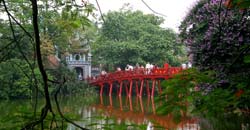 Ha Noi, one of the most beautiful of the colonial Indochinese cities is often the start or end point of a trip to Vietnam, and what a great welcome or farewell it is. Simply bubbling charm, Ha Noi has gone through many changes in the last decade since Vietnam swung open its doors to tourism, yet it remains an marvelous city to experience.
Ha Noi, one of the most beautiful of the colonial Indochinese cities is often the start or end point of a trip to Vietnam, and what a great welcome or farewell it is. Simply bubbling charm, Ha Noi has gone through many changes in the last decade since Vietnam swung open its doors to tourism, yet it remains an marvelous city to experience.
Tree-lined boulevards slice through the up-market embassy district, while winding back-alleys littered with steaming street-side pho stalls are more the norm in the city's Old Quarter. It's a lively capital with often jam-packed (mostly motorcycle) traffic intermingled with everything from pedestrians and cyclos to heavy trucks and buses. As with Saigon in the south, there is food just about everywhere and travellers need not eat at the same place twice.
Outside the capital there's the spectacular Ha Long Bay -- which is an complete must see for any first time visitor to Vietnam. Travellers should not make the mistake of opting for a single-day rushed tour -- but give Ha Long Bay and Cat Ba Island much time -- there's nowhere else like it.
...................................................................................................................
North West Vietnam (Incl. Sapa)
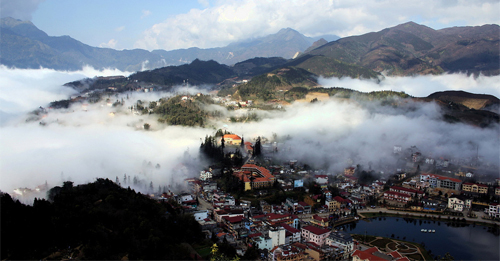 The remote northwest of Vietnam appeals to those wanting to get off the beaten track in one of Vietnam's most beautiful, unaffected and un-touristed areas.
The remote northwest of Vietnam appeals to those wanting to get off the beaten track in one of Vietnam's most beautiful, unaffected and un-touristed areas.
The travellers who do take on Mai Chau, Son La and Dien Bien Phu often do so by way of a hired jeep and driver or do it by motorbike, while those moving straight north to Vietnam's hill tribe capital of Sapa reward themselves of the restful and efficient overnight train to Sapa. Whichever way the traveller is headed, be prepared for stunning scenery as the train passes through spectacular ravines and over breathtaking passes.
Best known for the mushrooming trekking centre of Sapa, there is a lot more worth investigating in this part of the country. The remote French firebase of Dien Bien Phu remains a drawcard, but it's as much the attraction of the trip there as the town itself that is worth visiting. A trip to Dien Bien Phu is easily combined with an approach to Sapa via "the back way" over the Fansipan pass (Vietnam's highest), allowing for more stunning scenery and the opportunity to see some of the less touristed parts of the country.
Another popular destinations is Mai Chau whose day-trekking and stunning scenery have helped it develop into a small tourist centre en-route to Dien Bien Phu -- many trips from Ha Noi run out to Mai Chau -- and with good reason. It also forms a relaxing spot to rest those weary limbs before continuing onwards and up into the hills.
More and more travellers are now heading up into this part of the country, in part due to the long-awaited opening of the border crossing into Laos near Dien Bien Phu.
This is a time consuming part of Vietnam to visit, but, the northwest is well worth adding to trip plans.
...................................................................................................................
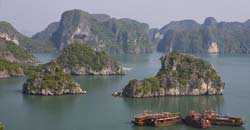 North East Vietnam (incl. Halong Bay)
North East Vietnam (incl. Halong Bay)
Between the Red River Delta and the sea, northeast Vietnam is an area rich in agriculture and history, as well as a regional engine of growth for industry and tourism. Scenic Halong Bay and Cat Ba Island draw endless crowds who sail peacefully through a dreamy seascape of rocky limestone outcrops, while the hustle and bustle of Haiphong makes it clear that this area is a vital artery in the country’s industry and trade.
Few visitors venture much beyond Halong Bay, but farther north the landscape is filled with dramatic mountain passes, towering waterfalls, lush national parks and ancient royal citadels. Ethnic hill-tribe minority villages, tucked away at the foot of mountains, offer trekking opportunities, while lakeside retreats are an escape from the stifling summer heat.
Cao Bang province has some of the country’s most beautiful scenery, with sweeping verdant hills and waterfalls. At Mong Cai, the easternmost border gate with China, goods (and people) pass in and out between the two countries, and beach resorts and colourful markets abound. China invaded, occupied and generally interfered with Vietnam for centuries, with the northeast being their principal gateway.
Chinese forces last entered Vietnam in 1979 as retaliation for the Vietnamese occupation of Cambodia, and the resulting war devastated parts of the region. These days, border trade is buoyant in some parts of the northeast, but the Vietnamese remain guarded about how much China and its now vast economic power may influence life here.
Halong Bay
No trip to northern Vietnam would be complete without visiting Halong Bay (Vinh Ha Long), one of the natural wonders of the world and truly one of the most stunning places in Southeast Asia. The bay’s tranquil beauty encompasses some 1,500 sq km (579 sq miles) of indigo sea and is dotted with over 3,000 limestone islands and rocky outcrops, almost all of them uninhabited. Oddly shaped rock sculptures jut dramatically from the sea, and numerous grottoes create an enchanted, timeless and almost mystical world.
Halong City (Ha Long) – about 3½ hours from Hanoi – is the main departure point for boat trips. It comprises two smaller towns, Bai Chay and Hon Gai: Bai Chay is the departure point for boat trips around the bay and is where the majority of hotels, tour agencies and restaurants are located. Shops here specialise in kitsch souvenirs fashioned from pearl, coral and limestone.
The best time to visit Halong is in warmer weather, from April to October, as you can swim off the boat and relax on sundecks. During the peak typhoon season in September, boats may cancel due to bad weather. Between January and March, the weather can be cool and drizzly, but even then, Halong Bay is a worthwhile excursion. It is important to note the weather before setting out as rough seas have led to serious accidents. Indeed, in 2011, two accidents, the first killing 12 tourists (the other, fortunately, had no fatalities), led to much new government oversight but little real development of safety standards. When it comes to Halong Bay tours, you get what you pay for. More expensive tours tend to have newer boats and higher safety standards.
Cat Ba Island
The Cat Ba Archipelago consists of 366 islets and islands peppered with beautiful beaches and grottoes. Just 20km (12 miles) from Haiphong, with the Gulf of Tonkin to the west and Halong Bay bordering to the east, the main Cat Ba Island covers about 354 sq km (137 sq miles), with a stunning landscape of forested hills, coastal mangroves and freshwater swamps, as well as lakes, waterfalls and reefs.
Cat Ba, overlooking the Gulf of Tonkin, is the island’s main settlement and port. Scattered along the coast are a number of floating fishing villages. Half of the island and 52 sq km (20 sq miles) of the surrounding inland waters are part of the Cat Ba National Park (Vuon Quoc Gia Cat Ba). The thickly forested island has a rich diversity of flora and fauna, with 69 bird species, numerous reptiles and 32 species of mammal, including the Cat Ba langur, leopard cat and serow.
Mong Cai
Mong Cai is one of three land border gates to China open to foreigners, though visas must be issued in either Hanoi or Beijing beforehand. A few kilometres to the east, on an island separated from the mainland by a narrow channel, is Tra Co Beach. It may be the north’s longest beach, at 17km (11 miles), which makes it relatively easy to find a quiet spot, but the sand is coarse and uninviting. At the southern end of the beach, you can catch a hydrofoil to Van Don Island (Dao Cai Bau), which is part of Halong Bay.
Haiphong
Haiphong, Vietnam’s third most populous city and the north’s most important port, is located in the northeast of the Bac Bo Delta. A small port town at the time of the French conquest in 1873, it quickly grew as the Europeans set about draining the surrounding swamps and constructing monumental buildings. Inside the boundaries of the Old City, wide shady streets, well-tended stands of greenery and a surprising number of colonial-era buildings are still in excellent condition.
The city centre curves around the Tam Bac River (Song Tam Bac). In this area there are several impressive colonial-era hotels, administrative buildings and the Haiphong Museum (Bao Tang Haiphong). At 56 Dinh Tien Hoang there is a square overlooked by the yellow, neo-colonial Grand Theatre, which dates back to 1912. The government has spent over US$6 million renovating the lavish interior.
The Du Hang Pagoda (Chua Du Hang), in the south of the city, was built in 1672 by a wealthy mandarin-turned-monk. It is dedicated to Le Chan, a female warrior who aided the Trung sisters in the uprising against the Chinese, AD39. The long, low wooden building, with its magnificent carvings and its swooping roof, is reached by passing through a triple-tiered bell tower and an open courtyard. Behind the carved offering table is a baby Buddha protected by nine dragons. The pagoda is situated on Pho Chua Hang, a lively and attractive street.
(From Insight Guides)
...................................................................................................................
North Central Vietnam (incl. Phong Nha, Ninh Binh)
 Not many travellers spend much time in north central Vietnam primarily because, well, it's not exactly overflowing with attractions -- of course for some, that's an attraction in itself, but for many, this region is little more than a blur out of a train or bus window.
Not many travellers spend much time in north central Vietnam primarily because, well, it's not exactly overflowing with attractions -- of course for some, that's an attraction in itself, but for many, this region is little more than a blur out of a train or bus window.
Nevertheless, this region of Vietnam stretches for more than 300km, from Ninh Binh in the north to the Demilitarised Zone to the south.
Working from north to south, a visit to Tam Coc near Ninh Binh should be on the travellers shortlist and the massive Phong Nha caverns down at the southern end in Dong Hoi province are unquestionably amazing. Between the two, there are a lot of very hospitable people, curiously wondering what travellers are doing in their home town, be it Ha Tinh, Thanh Hoa or Vinh. In this area the traverller will meet a lot more local people than in Hue, Nha Trang and Hoi An.
Another reason why travellers enter this region is because there are a couple of overland routes from Laos to Vietnam that empty out in this part of the country usually stopping at Thanh Hoa or Vinh -- both of which are more than adequate for an overnight stay before moving on to other, more interesting parts of the country.
Nevertheless, if you're after remote, un-touristed Vietnam, you're in the right place. This is Ho Chi Minh Trail country and motor bike trekkers find this one of the better, more exciting, regions to travel.
...................................................................................................................
Central Highlands Vietnam (incl. Da Lat)
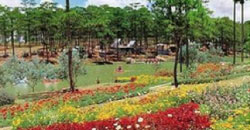 Vietnam's Central Highlands boast beautiful natural features such as relatively untouched forests, waterfalls and spectacular scenery, which contrast with areas still bearing the savage scars of war. A large number of ethnic minority groups still live traditionally in the highlands, particularly around Kon Tum, Plei Ku, Buon Ma Thuot and Da Lat.
The highlands become a torrent of water in the monsoon season as they get the heaviest rain falls in all of Vietnam. During the summer season, Da Lat becomes a popular destination as its high altitude offers a slightly cooler temperature than the almost unbearable heat of the southern plains. This, combined with its proximity to Ho Chi Minh City and some great animal-shaped paddle boats plying its main lake, has made it the epicentre of domestic tourism.
For those who enjoy getting off the common tourist trail, the highlands are a great destination. It is quite easy to include a detour to this historically significant region as a circuit from the coast, leaving and returning from either Qui Nhon or Nha Trang, with a separate excursion required to reach Da Lat from Phan Rang or Ho Chi Minh City. Two weeks would allow ample time to explore, while in one week would see the basics.
Vietnam's Central Highlands boast beautiful natural features such as relatively untouched forests, waterfalls and spectacular scenery, which contrast with areas still bearing the savage scars of war. A large number of ethnic minority groups still live traditionally in the highlands, particularly around Kon Tum, Plei Ku, Buon Ma Thuot and Da Lat.
The highlands become a torrent of water in the monsoon season as they get the heaviest rain falls in all of Vietnam. During the summer season, Da Lat becomes a popular destination as its high altitude offers a slightly cooler temperature than the almost unbearable heat of the southern plains. This, combined with its proximity to Ho Chi Minh City and some great animal-shaped paddle boats plying its main lake, has made it the epicentre of domestic tourism.
For those who enjoy getting off the common tourist trail, the highlands are a great destination. It is quite easy to include a detour to this historically significant region as a circuit from the coast, leaving and returning from either Qui Nhon or Nha Trang, with a separate excursion required to reach Da Lat from Phan Rang or Ho Chi Minh City. Two weeks would allow ample time to explore, while in one week would see the basics.
...................................................................................................................
Central Vietnam
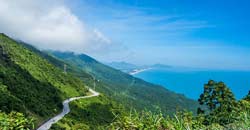 The Ben Hai River in Central Vietnam marks the 17th parallel, which once marked the demarcation line between North and South Vietnam. Though reunited over two decades ago, the north south division of Vietnam remains obvious. When the Ben Hai River is crossed from north to south, everything seems to improve, roads and food being the most obvious.
The Ben Hai River in Central Vietnam marks the 17th parallel, which once marked the demarcation line between North and South Vietnam. Though reunited over two decades ago, the north south division of Vietnam remains obvious. When the Ben Hai River is crossed from north to south, everything seems to improve, roads and food being the most obvious.
Central Vietnam is home to a wealth of attractions from the ancient imperial capital of Hue to the cosmopolitan shopping and the beach destinations of Hoi An and China Beach.
The region is home to the Demilitarised Zone (DMZ) which was the scene of heavy fighting during the American war. This part of the country is dotted with all manner of war-period attractions, including the remains of Khe Sanh and other US bases along the DMZ. Unfortunately, little remains at most of these sites as time and scrap hunters have had their way.
The one exception is the Vinh Moc tunnels -- a breathtaking testament of the tenacity of the Vietnamese people and a far more worthwhile attraction than the far more touristic Cu Chi tunnels.
Most travellers to Vietnam pencil in Hue and Hoi An as definite "must sees" but then fail to allow themselves enough time in each town. This is particularly the case with Hoi An, where, while it can feel almost ‘Disneylandish’ at times, people are always running out of time. If you allowed just a couple of days for Hoi An, be sure to double it.
And don't forget Da Nang. It's home to more than just the closest airport to Hoi An! There's also a terrific Cham Museum, China Beach and an overall rather fun, non-touristy Vietnamese city.
For travellers on motorbike, a highlight is the Hai Van Pass, near Da Nang, one of the world’s most scenic coastal drives.
The most spectacular section spans 21 kilometers and comprises a series of hairpin turns, steep inclines and breathtaking vistas. Reaching an elevation of 496 meters, Hai Van Pass (meaning ‘Ocean Cloud Pass’) is often shrouded in mist that rises from the sea.
A mountain pass of historical strategic importance, it also serves as the boundary between the climates of northern and southern Vietnam, sheltering Da Nang from the ‘Chinese winds’ that blow in from the northwest. Sometimes the pass is covered by mist from the ocean giving the impression that you are travelling through the clouds as you drive. On a sunny day, Hai Van Pass offers you terrific panoramic views of Da Nang City, Son Tra Peninsula, Tien Sa Port and endless white-sand beaches.
(From: www.travelfish.org ¢ralcoastvietnam.com)
...................................................................................................................
Ho Chi Minh City & Environs
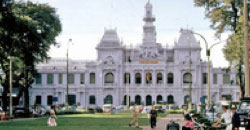 Not many travellers spend much time in north central Vietnam primarily because, well, it's not exactly overflowing with attractions -- of course for some, that's an attraction in itself, but for many, this region is little more than a blur out of a train or bus window.
Not many travellers spend much time in north central Vietnam primarily because, well, it's not exactly overflowing with attractions -- of course for some, that's an attraction in itself, but for many, this region is little more than a blur out of a train or bus window.
Nevertheless, this region of Vietnam stretches for more than 300km, from Ninh Binh in the north to the Demilitarised Zone to the south.
Working from north to south, a visit to Tam Coc near Ninh Binh should be on the travellers shortlist and the massive Phong Nha caverns down at the southern end in Dong Hoi province are unquestionably amazing. Between the two, there are a lot of very hospitable people, curiously wondering what travellers are doing in their home town, be it Ha Tinh, Thanh Hoa or Vinh. In this area the traverller will meet a lot more local people than in Hue, Nha Trang and Hoi An.
Another reason why travellers enter this region is because there are a couple of overland routes from Laos to Vietnam that empty out in this part of the country usually stopping at Thanh Hoa or Vinh -- both of which are more than adequate for an overnight stay before moving on to other, more interesting parts of the country.
Nevertheless, if you're after remote, un-touristed Vietnam, you're in the right place. This is Ho Chi Minh Trail country and motor bike trekkers find this one of the better, more exciting, regions to travel.
...................................................................................................................
Vietnam-Laos Adventure
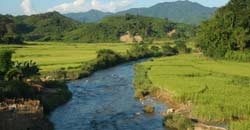 For the adventurous, a trip to northern Vietnam can be combined with a trip to remote areas of northeast Laos. The Vietnam-Laos border can be crossed near Dien Bien Phu or at Na Meo, west of Thanh Hoa. The highlights of northeast Laos include historical Vieng Xay, Nam Et-Phou Louey National Protected Area, relaxing Nong Khiaw and the royal capital, Luang Prabang.
For the adventurous, a trip to northern Vietnam can be combined with a trip to remote areas of northeast Laos. The Vietnam-Laos border can be crossed near Dien Bien Phu or at Na Meo, west of Thanh Hoa. The highlights of northeast Laos include historical Vieng Xay, Nam Et-Phou Louey National Protected Area, relaxing Nong Khiaw and the royal capital, Luang Prabang.
Landlocked Laos is one of the Asia's most enchanting destinations. Stunning natural beauty -- think mist-shrouded mountain peaks flanked by jungle-clad valleys teeming with wildlife -- combine with a fascinating Buddhist culture to make Laos a superb destination for backpackers and independent travellers, while luxury tourists are now also well-catered for.
Communist Laos flung open its doors to tourism in the early 1990s. The last decade has witnessed an explosion in development as businesses -- some Lao, some foreign -- mushroom to cater to the swelling crowds.
Laos is changing fast, but pockets remain well off-the-beaten-track, ready to be explored by adventure travellers willing to forego the usual tourist luxuries. Those who want to experience a real taste of rural Southeast Asian life will be delighted.
Laos attracts many travellers who consider northern Thailand to now be over-developed or "touristed out" and are looking for places less inundated with foreigners.
(From: www.travelfish.org)
...................................................................................................................
Ho Chi Minh Trail
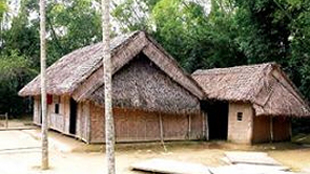 The Ho Chi Minh Trail was a strategic network of paths and roads from north Vietnam to south Vietnam that supplied the southern battlefields during the American-Vietnam War. Parts of this network have now been upgraded to form the Ho Chi Minh Highway. The trail passes through historic locations from the war, World Heritage sites, pristine jungle and offers easy access to the beaches on the coast.
The Ho Chi Minh Trail was a strategic network of paths and roads from north Vietnam to south Vietnam that supplied the southern battlefields during the American-Vietnam War. Parts of this network have now been upgraded to form the Ho Chi Minh Highway. The trail passes through historic locations from the war, World Heritage sites, pristine jungle and offers easy access to the beaches on the coast.
Highlights of the train in the Central Vietnam section include the Phong Nha-Ke Bang National Park, Khe Sanh and the former demilitarised zone (DMZ), the former imperial capital at Hue, the historic trading port of Hoi An and a ride over the beautiful Hai Van pass.
From Hoi An, the Ho Chi Minh Trail continues to the Central Highlands and Nha Trang.
It takes a minimum of six days to ride the Ho Chi Minh Trail from Hanoi to Hoi An by motorbike, and a minimum 12 days to ride from Hanoi to Ho Chi Minh City. It is recommended that more time should be added to allow for rest days at the top spots along the way.
...................................................................................................................
Mekong Delta
 The Mekong Delta forms both the far southern region of Vietnam and one of country's two main rice bowls. Dominated by the Mekong River and its many tributaries, the surrounding lands are comprised of low lying rice paddies and the rivers are bordered by dense mangroves and palms. The tributaries of the hectic Mekong River highway provide a widespread network of canals and channels acting as on and off ramps to the main thoroughfare. For the independent traveller, these rivers and tributaries can be the best method to explore the Mekong Delta at a leisurely pace and offer the opportunity to experience the unique Mekong River lifestyle.
By embarking on a comprehensive exploration of the Delta, visitors will have the opportunity to observe and participate in an extra dimension of Vietnamese life and culture. The attractions of this region of Vietnam include the way in which life exists around the comprehensive river system, the heavy Khmer influence from nearby Cambodia and the extensive coastline, boasting some of the nicer beaches in Vietnam.
For those travellers with time on their hands, at least a month could be spent exploring this part of Vietnam. Those unfortunate enough to have a time limit for their stay in Vietnam should be spending a longer time in one region of the Delta rather than attempting to see every centre in seven to ten days, as transport, especially during the wet season, can be very slow and uncomfortable. However, cruising up one of the many rivers as the sun declines over the distant coconut trees, is a truly remarkable experience that would remain with visitors forever.
The Mekong Delta forms both the far southern region of Vietnam and one of country's two main rice bowls. Dominated by the Mekong River and its many tributaries, the surrounding lands are comprised of low lying rice paddies and the rivers are bordered by dense mangroves and palms. The tributaries of the hectic Mekong River highway provide a widespread network of canals and channels acting as on and off ramps to the main thoroughfare. For the independent traveller, these rivers and tributaries can be the best method to explore the Mekong Delta at a leisurely pace and offer the opportunity to experience the unique Mekong River lifestyle.
By embarking on a comprehensive exploration of the Delta, visitors will have the opportunity to observe and participate in an extra dimension of Vietnamese life and culture. The attractions of this region of Vietnam include the way in which life exists around the comprehensive river system, the heavy Khmer influence from nearby Cambodia and the extensive coastline, boasting some of the nicer beaches in Vietnam.
For those travellers with time on their hands, at least a month could be spent exploring this part of Vietnam. Those unfortunate enough to have a time limit for their stay in Vietnam should be spending a longer time in one region of the Delta rather than attempting to see every centre in seven to ten days, as transport, especially during the wet season, can be very slow and uncomfortable. However, cruising up one of the many rivers as the sun declines over the distant coconut trees, is a truly remarkable experience that would remain with visitors forever.
...................................................................................................................
